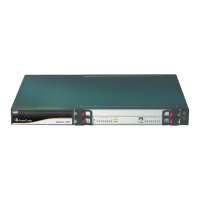User's Manual 714 Document #: LTRT-89730
Mediant 3000
Upon startup, the device searches for Option 66 in the DHCP response from the DHCP
server. If Option 66 contains a valid IP address, the device attempts to download, through
TFTP, a file that has a filename containing the device's MAC address (e.g.,
00908f0130aa.ini). This method requires a provisioning server at the customer premises.
This method loads the configuration file to the device as a one-time action. The download
is only repeated if the device is manually restored to factory defaults (by pressing the
hardware reset button while the Ethernet cable is not connected) and DHCP is enabled
(see note below).
Notes:
• For TFTP configuration using DHCP Option 66, enable DHCP on your device:
DHCPEnable = 1 and DHCPRequestTFTPParams = 1.
• Access to the core network using TFTP is not NAT-safe.
• The TFTP data block size (packets) when downloading a file from a TFTP server
for the Automatic Update mechanism can be configured using the
AUPDTftpBlockSize parameter.
46.1.4 HTTP-based Provisioning
An HTTP or HTTPS server can be located in the network in which the device is deployed,
storing configuration and software files for the device to download. This does not require
additional servers and is NAT-safe.
For example, assume the core network HTTPS server is https://www.corp.com. A master
configuration ini file can be stored on the server, e.g.,
https://www.corp.com/gateways/master.ini. This file could point to additional ini files,
Auxiliary files (e.g., call progress tones), and software files (cmp), all on the same HTTP
server or different HTTP servers in the network.
The main advantage of this method is that the device can be configured to periodically
check the HTTP server for file updates. HTTP(S) is not sensitive to NAT devices, enabling
configuration whenever needed without on-site intervention. For additional security, the
URL may contain a different port, and username and password.
The only configuration required is to preconfigure the device(s) with the URL of the initial
(master) ini file. This can be done using one of the following methods:
DHCP as described in ''DHCP-based Provisioning'' on page 711 or via TFTP at a
staging warehouse. The URL is configured using the IniFileURL parameter.
Private labeling (preconfigured during the manufacturing process).
Using DHCP Option 67 (see Provisioning from HTTP Server using DHCP Option 67
on page
713).
Manually on-site, using the RS-232 port or Web interface.
When the device is deployed at the customer site, local DHCP server provides the devices
with IP addressing and DNS server information. From the URL provided in the DHCP
response, the device can then contact the HTTP server at the core network and
automatically download its configuration. The URL can be a simple file name or contain the
device's MAC or IP address, e.g.:
http://corp.com/config-<MAC>.ini - which becomes, for example,
http://corp.com/config-00908f030012.ini
http://corp.com/<IP>/config.ini - which becomes, for example,
http://corp.com/192.168.0.7/config.ini
For more information on HTTP-based provisioning, see ''HTTP/S-Based Provisioning using
the Automatic Update Feature'' on page 716.

